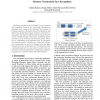Free Online Productivity Tools
i2Speak
i2Symbol
i2OCR
iTex2Img
iWeb2Print
iWeb2Shot
i2Type
iPdf2Split
iPdf2Merge
i2Bopomofo
i2Arabic
i2Style
i2Image
i2PDF
iLatex2Rtf
Sci2ools
CVPR
2012
IEEE
2012
IEEE
Memory constrained face recognition
Real-time recognition may be limited by scarce memory and computing resources for performing classification. Although, prior research has addressed the problem of training classifiers with limited data and computation, few efforts have tackled the problem of memory constraints on recognition. We explore methods that can guide the allocation of limited storage resources for classifying streaming data so as to maximize discriminatory power. We focus on computation of the expected value of information with nearest neighbor classifiers for online face recognition. Experiments on real-world datasets show the effectiveness and power of the approach. The methods provide a principled approach to vision under bounded resources, and have immediate application to enhancing recognition capabilities in consumer devices with limited memory.
Computer Vision | Cvpr 2012 | Memory Constraints | Neighbor Classifiers | Recognition Capabilities |
| Added | 28 Sep 2012 |
| Updated | 28 Sep 2012 |
| Type | Journal |
| Year | 2012 |
| Where | CVPR |
| Authors | Ashish Kapoor, Simon Baker, Sumit Basu, Eric Horvitz |
Comments (0)

